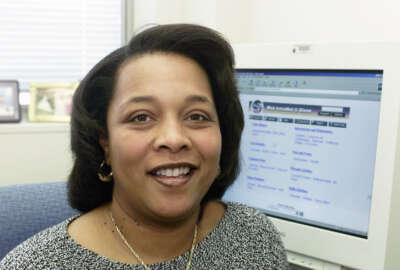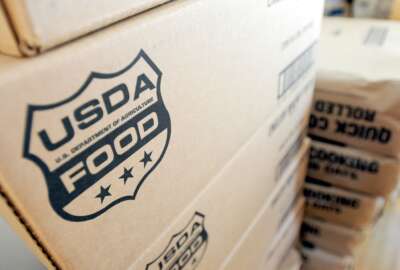
NASA, National Science Foundation cozy up in a little scientific kumbaya
Two of the government's biggest research agencies have signed a new MOU they say reaffirms a long history of cooperation. With details, Tom Temin spoke to NASA'...
Best listening experience is on Chrome, Firefox or Safari. Subscribe to Federal Drive’s daily audio interviews on Apple Podcasts or PodcastOne.
Two of the government’s biggest research and research funding agencies have signed a new memorandum of understanding they say reaffirms a long history of cooperation. With the details, NASA’s acting associate administrator for international and interagency affairs, Mike Gold, joined Federal Drive with Tom Temin.
Interview transcript:
Mike Gold: It’s such a pleasure to be back. Thanks for having me again.
Tom Temin: And this latest memorandum of understanding is with the National Science Foundation. Tell us what it covers.
Mike Gold: That might take up the rest of the morning Tom. There is nearly nothing that NASA does that isn’t informed by the work of the National Science Foundation. It’s an extraordinarily broad collaboration, as you might imagine, from the scope and scale of what the NSF does. Everything from climate science and understanding climate change, and really integrating climate data so that we can take what we gather from everything, from weather balloons to satellites to data across the world to create a model of what Earth’s atmosphere and climate looks like so we can learn and tackle the existential threat of our time with climate change issues. Moreover, as we move out into space, there’s a vast amount of work that can occur and is on the International Space Station. Microgravity is a whole new realm for scientific discovery. And whether it’s quantum technology or basic physics, there’s so much that we’re learning together with our partner from the NSF that will bolster both space exploration, while increasing our economic competitiveness and scientific discoveries. It’s just a panacea of wonderful things for the country and the world via this NASA and NSF partnership.
Tom Temin: I’m looking at the list of categories in which the two will work together, you and NSF, space science, Earth system science, human exploration and operations, space life sciences, space physical sciences, space technology, citizen science and science, technology, STEM, engineering and math education. So there is a space orientation to this. Is part of this a way to coordinate research grants and research funding and research activities such that you avoid duplication perhaps and get cross fertilization from a single grant or a single research associate?
Mike Gold: Absolutely. We want to make sure that we’re always good stewards of taxpayer money. And this is why this kind of collaboration/relationship is so important. As you point out, we not only eliminate any redundancies or duplication, but there’s a tremendous amount of synergy between what we do and what the NSF is researching. And we each have such unique and singular facilities. If you look at the McMurdo Station that NSF has in Antarctica, that is an unparalleled platform for a lot of the climate research that we do. But even discovering ancient asteroids, so there’s a space component to that as well. Then you have the International Space Station on the NASA side that, again, is a completely unique facility. And by leveraging those facilities, by leveraging the different scientific activities that we do, we’re able to make each other’s research so much better, enhance the capabilities, and really boldly go where no two of these organizations have gone before. We’re doing much more together than we ever could apart.
Tom Temin: And how does this work in a day to day sense? Are there people from NSF embedded at NASA and vice versa, that kind of thing?
Mike Gold: So we don’t work with embeds per se, but it’s communication between the program directors. Again, leveraging facilities, time, etc. Let me maybe give you a quick example for you and your listeners, and one that I think is particularly important when it comes to quantum technology. Right now, we’re looking at a phenomenon called quantum entanglement where you get a pair of photons entangled in a way that communication of information occurs between the two of them in a very expeditious fashion. As a matter of fact, the communication is instantaneous, actually breaking the speed of light. It’s a phenomena that Einstein looked at way back in the day and is fascinating today. I do try not to break the laws of physics too many times before lunch, but given this conversation, I have to point it out this extraordinary phenomena. So we’re working with lasers on the International Space Station to entangle these photons and do experiments with quantum communication to the ground via this quantum initiative. That’s we’re working in partnership with the NSF. So that’s a good example of a collaboration where our people on the International Space Station, we’re leveraging our facilities to support research conducted by the NSF and other agencies, on what’s an absolutely critical issue for the future. I know that you and your listeners are going to be hearing a lot more about quantum technology, whether that’s quantum computing, whether that’s quantum communications as I was describing, or quantum encryption, even quantum sensors are being developed. And I truly believe that the countries and companies that excel in quantum technology are going to be the scientific and economic leaders of the future.
Tom Temin: Well with those photons playing together so nicely, it sounds like an astronaut could talk to Earth and the words would get there before he said them.
Mike Gold: Absolutely. And I’m looking forward to having just some clear cell signals in the Washington DC area.
Tom Temin: Yeah, that would be a certainly a practical application of that kind of thing. And tell us a little bit more about the STEM initiative part of this memorandum.
Mike Gold: I’m glad you raised that, Tom, because diversity is so important for innovation. We need to make sure that all of America is engaged when it comes to science. That the diverse nature of the American population drives innovation, it’s really the United States great advantage. And that’s why it’s so terrific to work with the NSF on a program they have called the inclusion across the nation of communities of learners of under representative discoverers in engineering and science and that spells out INCLUDES, which is exactly what they’re trying to do. And we’re working with him on a number of NASA programs as well. We’re collaborating with researchers at minority serving institutions through our own Minority University Research and Education Project in the Office of STEM Engagement. So not only are we working on the substantive science with the NSF, but we’re trying to make sure that together, there is a new generation and a larger and broader and more diverse generation of engineers, because we’re going to need every one of those STEM professionals to be competitive, to be supportive and to improve life in the future.
Tom Temin: And not to get too prosaic, but in the preparation of research budgets that are submitted up through the White House and eventually to Congress, is there some level of coordination there also?
Mike Gold: Absolutely, that’s what these MOUs are intended to do, again, to ensure that we’re leveraging our facilities fully, not only for our own activities, but to take a holistic look at research across the federal government and ensure that we’re acting as efficiently as possible relative to our appropriations, as well as our facilities and time.
Tom Temin: And there’s a very, very long bulleted list of areas to cooperate on this specific interest, including but not limited to list — and looking way down on there, there is a national robotics initiative. briefly tell us what that’s all about.
Mike Gold: Absolutely. So robotics as you know is generally applicable to almost every industrial field here on Earth. And it’s vital for space exploration, that without robotics assistance, robotic capabilities, not only are pure robotic probes such as Mars perseverance, which is nearly at Mars now, we’ve got a mission arriving that will be next month. But even our human spaceflight activities on the International Space Station, there’s the Canada arm that’s contributed by our friends and colleagues at the Canadian Space Agency. Everything that we do in the space is assisted by robotics, in part because of the harshness of the environment and it helps protect our astronauts the more that we can combine their activities with robotics. And that’s only going to become more true as we move beyond low Earth orbit to the Moon, Mars and beyond. And that’s because of the radiation environment that when we operate in low Earth orbit, we’re protected essentially by the Earth’s shield. If you want to use a sci-fi term, the Earth provides shields due to its magnetic field around Earth and Earth orbit that protects us from solar flares, cosmic rays, but when astronauts move beyond that, it’s a much more pernicious environment where robotics will be key. And frankly, learning how technologies and systems operate in a harsh radiation environment like that. And that is an area that we’re collaborating with the NSF on.
Tom Temin: Well, lots of fascinating things there. Now this agreement was signed by Dr. Panchanathan of the NSF and Jim Bridenstine, the administrator of NASA in the last administration. I’m presuming this survives the transition to the Biden administration.
Mike Gold: I think we’ve seen a pretty clear indication from the president’s team about the importance of science, the importance of climate change, and the importance of addressing these issues and moving American, the world, ahead when it comes to scientific knowledge and creating all of these new wonderful discoveries that will transform our lives and improve the human condition here in America and throughout the world. So I think we’re looking at a very robust future for science, climate study, fundamental physics and all of the wonderful activities that are occurring vis-à-vis the this collaboration.
Tom Temin: Mike Gold is associate administrator for policy and partnerships at NASA. Thanks for joining me.
Mike Gold: Thank you Tom. It’s a pleasure and keep looking towards the stars.
Copyright © 2024 Federal News Network. All rights reserved. This website is not intended for users located within the European Economic Area.
Tom Temin is host of the Federal Drive and has been providing insight on federal technology and management issues for more than 30 years.
Follow @tteminWFED
Related Stories

NASA and USDA looking to conduct more research together




